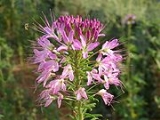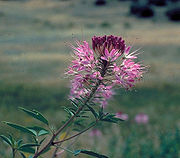
Beeweed
Encyclopedia
Cleome serrulata is a species of Cleome
, native to western North America
from southern British Columbia
, east to Minnesota
and Illinois
, and south to New Mexico
and northernmost California
. It is also naturalized
further east in North America.
 It is an annual plant
It is an annual plant
growing to 10-150 cm (4-60 in) tall, with spirally arranged leaves. The leaves
are trifoliate, with three slender leaflets each 1-7 cm (0.4-2.75 in) long. The flower
s are reddish-purple, pink, or white, with four petals and six long stamens. The fruit
is a capsule
3-6cm (1-2.4 in) long containing several seeds.
described this species in the first volume of Flora Americae Septentrionalis.
In the first volume of Prodromus Systematis Naturalis Regni Vegetabilis
in 1824 Augustin Pyramus de Candolle moved this species into his idea of what the genus Peritoma should be, calling it Peritoma serrulatum.
In 1901, Edward Lee Greene
built a genus of Cleome species based on Candolles Peritoma including this species as Peritoma serrulatum DC. and Peritoma lutem
Raf. Other species that were included have since been determined to be synonyms of these species.
Taxonomy references
Cleome
Cleome is a genus of flowering plants in the family Cleomaceae. Previously it had been placed in family Capparaceae, until DNA studies found the Cleomaceae genera to be more closely related to Brassicaceae than Capparaceae...
, native to western North America
North America
North America is a continent wholly within the Northern Hemisphere and almost wholly within the Western Hemisphere. It is also considered a northern subcontinent of the Americas...
from southern British Columbia
British Columbia
British Columbia is the westernmost of Canada's provinces and is known for its natural beauty, as reflected in its Latin motto, Splendor sine occasu . Its name was chosen by Queen Victoria in 1858...
, east to Minnesota
Minnesota
Minnesota is a U.S. state located in the Midwestern United States. The twelfth largest state of the U.S., it is the twenty-first most populous, with 5.3 million residents. Minnesota was carved out of the eastern half of the Minnesota Territory and admitted to the Union as the thirty-second state...
and Illinois
Illinois
Illinois is the fifth-most populous state of the United States of America, and is often noted for being a microcosm of the entire country. With Chicago in the northeast, small industrial cities and great agricultural productivity in central and northern Illinois, and natural resources like coal,...
, and south to New Mexico
New Mexico
New Mexico is a state located in the southwest and western regions of the United States. New Mexico is also usually considered one of the Mountain States. With a population density of 16 per square mile, New Mexico is the sixth-most sparsely inhabited U.S...
and northernmost California
California
California is a state located on the West Coast of the United States. It is by far the most populous U.S. state, and the third-largest by land area...
. It is also naturalized
Naturalisation (biology)
In biology, naturalisation is any process by which a non-native organism spreads into the wild and its reproduction is sufficient to maintain its population. Such populations are said to be naturalised....
further east in North America.
Description

Annual plant
An annual plant is a plant that usually germinates, flowers, and dies in a year or season. True annuals will only live longer than a year if they are prevented from setting seed...
growing to 10-150 cm (4-60 in) tall, with spirally arranged leaves. The leaves
Leaf
A leaf is an organ of a vascular plant, as defined in botanical terms, and in particular in plant morphology. Foliage is a mass noun that refers to leaves as a feature of plants....
are trifoliate, with three slender leaflets each 1-7 cm (0.4-2.75 in) long. The flower
Flower
A flower, sometimes known as a bloom or blossom, is the reproductive structure found in flowering plants . The biological function of a flower is to effect reproduction, usually by providing a mechanism for the union of sperm with eggs...
s are reddish-purple, pink, or white, with four petals and six long stamens. The fruit
Fruit
In broad terms, a fruit is a structure of a plant that contains its seeds.The term has different meanings dependent on context. In non-technical usage, such as food preparation, fruit normally means the fleshy seed-associated structures of certain plants that are sweet and edible in the raw state,...
is a capsule
Capsule (fruit)
In botany a capsule is a type of simple, dry fruit produced by many species of flowering plants. A capsule is a structure composed of two or more carpels that in most cases is dehiscent, i.e. at maturity, it splits apart to release the seeds within. A few capsules are indehiscent, for example...
3-6cm (1-2.4 in) long containing several seeds.
Taxonomy
In 1817, Frederick Traugott PurshFrederick Traugott Pursh
Frederick Traugott Pursh was a German-American botanist.Born in Grossenhain, Saxony, to the name Friedrich Traugott Pursh, he was educated at Dresden Botanical Gardens, and emigrated to the United States in 1799...
described this species in the first volume of Flora Americae Septentrionalis.
In the first volume of Prodromus Systematis Naturalis Regni Vegetabilis
Prodromus Systematis Naturalis Regni Vegetabilis
Prodromus Systematis Naturalis Regni Vegetabilis, also known by its standard botanical abbreviation Prodr. , is a 17-volume treatise on botany initiated by A. P. de Candolle. De Candolle intended it as a summary of all known seed plants, encompassing taxonomy, ecology, evolution and biogeography....
in 1824 Augustin Pyramus de Candolle moved this species into his idea of what the genus Peritoma should be, calling it Peritoma serrulatum.
In 1901, Edward Lee Greene
Edward Lee Greene
Edward Lee Greene, Ph.D., was an American botanist known for his numerous publications including the two-part Landmarks of Botanical History and the naming or redescribing of over 4,400 species of plants in the American West.- Early Life :Edward Lee Greene was born on August 20, 1843 in...
built a genus of Cleome species based on Candolles Peritoma including this species as Peritoma serrulatum DC. and Peritoma lutem
Cleome lutea
Cleome lutea is a species of cleome known by the common names yellow bee plant and yellow spiderflower. This annual wildflower is native to the western United States where it is most common in desert scrub and plateau habitats. It is a sprawling plant often exceeding a meter in height...
Raf. Other species that were included have since been determined to be synonyms of these species.
Taxonomy references
-
-
-
Uses
It is used in the southwestern U.S. as a food, medicine, or dye. It is called waa’ in the Navajo languageNavajo languageNavajo or Navaho is an Athabaskan language spoken in the southwestern United States. It is geographically and linguistically one of the Southern Athabaskan languages .Navajo has more speakers than any other Native American language north of the...
. Its scientific description was based on specimens collected on the Lewis and Clark ExpeditionLewis and Clark ExpeditionThe Lewis and Clark Expedition, or ″Corps of Discovery Expedition" was the first transcontinental expedition to the Pacific Coast by the United States. Commissioned by President Thomas Jefferson and led by two Virginia-born veterans of Indian wars in the Ohio Valley, Meriwether Lewis and William...
.
-
-

